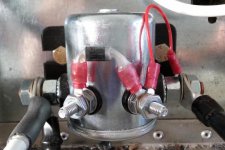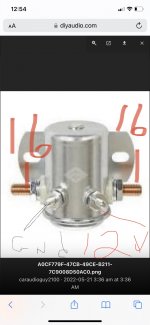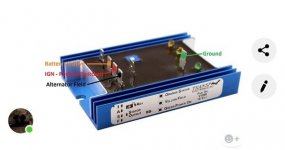Ok this is how I’m going to wire the solenoid in the charging system .
1 lug has a wire coming from the alternator charging post .
The other lug is going to the external regulator
1 small lug is going to switched ignition wire
Other small lug is going to ground .
Since this is how I’m going to use this solenoid the diodes would still be a good idea correct ?
I will have to open the link on a computer but what diodes should I buy ?
1 lug has a wire coming from the alternator charging post .
The other lug is going to the external regulator
1 small lug is going to switched ignition wire
Other small lug is going to ground .
Since this is how I’m going to use this solenoid the diodes would still be a good idea correct ?
I will have to open the link on a computer but what diodes should I buy ?
Do you happen to have a pic of how I’m suppose to wire the diodes online with the coils for some reason my computer won’t let me view the page
Neither of the small terminals will connect to 16v. One will connect to ground. The other to your switched 12v. The striped end of the diode will go to the 12v terminal.
Until you get this connected and working, I'd suggest inserting a 5 amp fuse in the switched 12v line feeding the relay. It wouldn't hurt to leave it in the circuit in case the diode would short.
Until you get this connected and working, I'd suggest inserting a 5 amp fuse in the switched 12v line feeding the relay. It wouldn't hurt to leave it in the circuit in case the diode would short.
So when the solenoid is closed (by the 12V ign signal) the output of the alternator is connected to the input of the regulator. That is the normal situation?
If the solenoid is open (no ign signal) the alternator is not connected to the regulator, right.
What use is that? If ign is off, the car is at standstill, and the alternator doesn't generate. Why do you need to disconnect it?
Just trying to figure out what the purpose is.
Jan
If the solenoid is open (no ign signal) the alternator is not connected to the regulator, right.
What use is that? If ign is off, the car is at standstill, and the alternator doesn't generate. Why do you need to disconnect it?
Just trying to figure out what the purpose is.
Jan
I’m not disconnecting anything .
Let me explain this another way .
The vehicle right now as it sits it 100% stock . It has the stock charging system in place .
I’m leaving the stock charging system in place not touching it at all . The stock charging system is to run all the electronics that were on the vehicle when I bought it dash lights heater ect ect .
Im adding a 2nd alternator to the vehicle which will only charge the battery that’s located in the rear to run the audio system and be completely isolated from the 12 volt system .
The alternator was built to charge at 15.5 volts with an external regulator. So the cmax battery in the rear of vehicle will be charging at 15.5 volts .
Since this alternator was built for 15.5 volts and is completely isolated from the 12 volt system The external regulator needs to see a switched ignition wire that is 15.5 volts not 12 volts .
So I’m using the solenoid to make a switched 15.5 volt ignition wire . Taking the voltage 15.5 off the alternator stud and connecting it to the solenoid Then the other side of the solenoid goes to the regulator . The 2 small terminals on the regulator 1 of them goes to a switched 12 volt ign wire to turn the solenoid on and off the other Terminal goes to ground .
Hope this makes sense
Let me explain this another way .
The vehicle right now as it sits it 100% stock . It has the stock charging system in place .
I’m leaving the stock charging system in place not touching it at all . The stock charging system is to run all the electronics that were on the vehicle when I bought it dash lights heater ect ect .
Im adding a 2nd alternator to the vehicle which will only charge the battery that’s located in the rear to run the audio system and be completely isolated from the 12 volt system .
The alternator was built to charge at 15.5 volts with an external regulator. So the cmax battery in the rear of vehicle will be charging at 15.5 volts .
Since this alternator was built for 15.5 volts and is completely isolated from the 12 volt system The external regulator needs to see a switched ignition wire that is 15.5 volts not 12 volts .
So I’m using the solenoid to make a switched 15.5 volt ignition wire . Taking the voltage 15.5 off the alternator stud and connecting it to the solenoid Then the other side of the solenoid goes to the regulator . The 2 small terminals on the regulator 1 of them goes to a switched 12 volt ign wire to turn the solenoid on and off the other Terminal goes to ground .
Hope this makes sense
No.... not sensible at all.
What is the battery voltage in the rear compartment?
12V battery has a max. charging volts about 14.5...So what is the extra voltage charging?
A special voltage battery, not a lead acid regular vehicle battery?
Anyway, the above wiring scheme in post #28 is correct, but the need for a solenoid is not there, there are separate batteries off separate alternators, no point in putting a solenoid.
The alternator regulator will charge the battery just fine, same as in all other cars and so on.
They do not have a switch / relay / solenoid.
To be clear:
... big terminals for 16 V (load), small terminals (control signal): one is +12V, striped end of diode to that, and the other side of diode to other terminal, which is connected to -12V or ground.
But superfluous for isolated circuits in my opinion...
What is the battery voltage in the rear compartment?
12V battery has a max. charging volts about 14.5...So what is the extra voltage charging?
A special voltage battery, not a lead acid regular vehicle battery?
Anyway, the above wiring scheme in post #28 is correct, but the need for a solenoid is not there, there are separate batteries off separate alternators, no point in putting a solenoid.
The alternator regulator will charge the battery just fine, same as in all other cars and so on.
They do not have a switch / relay / solenoid.
To be clear:
... big terminals for 16 V (load), small terminals (control signal): one is +12V, striped end of diode to that, and the other side of diode to other terminal, which is connected to -12V or ground.
But superfluous for isolated circuits in my opinion...
Last edited:
It’s a cmax battery that was built to take that charging voltage . Yes this battery and alternator were designed and built to this voltage .
Forget everything about 12 volts . This is a 16 volt system not 12 . My amps are high voltage amps and to get more power out of them I need to run them at 15.5 volts .
And yes I do need the solenoid how else am i going to get a 16 volt switched ignition wire ?
The external voltage regulator needs to see a 16 volt switched power wire you cannot get a 16 volt switched power wire from 12 volts .
Forget everything about 12 volts . This is a 16 volt system not 12 . My amps are high voltage amps and to get more power out of them I need to run them at 15.5 volts .
And yes I do need the solenoid how else am i going to get a 16 volt switched ignition wire ?
The external voltage regulator needs to see a 16 volt switched power wire you cannot get a 16 volt switched power wire from 12 volts .
If you need high voltage, put the alternator from a 24V truck, and use that battery.
As it is they will be two units on two pulleys and two brackets, right?
I understand you need a 16V charger, but if all vehicle alternators have internal regulators, there is no need for an external one, and you do get them without a switch.
But to argue is not going to achieve much.
Check if your system can take 24V, and change over to that.
You will need less current for the same power, and parts will be stock, not exotic.
High voltage in solid state amps is above 80V, this is low in comparison.
As it is they will be two units on two pulleys and two brackets, right?
I understand you need a 16V charger, but if all vehicle alternators have internal regulators, there is no need for an external one, and you do get them without a switch.
But to argue is not going to achieve much.
Check if your system can take 24V, and change over to that.
You will need less current for the same power, and parts will be stock, not exotic.
High voltage in solid state amps is above 80V, this is low in comparison.
Last edited:
Why do you need to switch it? Why not just connect the 'special' alternator to the 'special' battery and be done? Just like the regular alternator and battery?And yes I do need the solenoid how else am i going to get a 16 volt switched ignition wire ?
It's two separate circuits anyway.
Jan
Chuck it and use a 24V truck alternator, with a 24V 120 or 150 Ah battery, if you can.
Plenty of reserve for a few hours, even with car parked.
Plenty of reserve for a few hours, even with car parked.
- Home
- General Interest
- Car Audio
- Continuous duty solenoid


